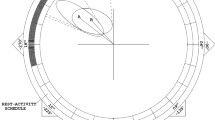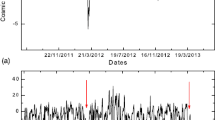Abstract
Space medicine was one of the first fields of science and practice to use the analysis of the heart rate variability (HRV) for obtaining new scientific information and solving the tasks of exercising medical control over humans working under extreme conditions. The theoretical basis of HRV analysis and different approaches to the assessment of the data obtained are presented in the work. The technique for HRV analysis with regard to the specifics of space studies is described. The results of investigations at different stages of the space flight, including the use of Holter monitoring, are presented. Special attention is given to the results of the investigations in a long-term 14-month space flight. The adaptation to long-term weightlessness was shown to be of a multistep character with the gradual involvement of additional regulatory mechanisms.
Similar content being viewed by others
REFERENCES
Parin, V.V., Baevsky, R.M., and Gazenko, O.G., Heart and Circulation under Space Conditions, Cor Vasa, 1965, vol. 7, no. 3, p. 165.
Zhemaitite, D.I., Autonomic Function of the Sinus Heart Rhythm in Healthy and Ill Individuals, in Analiz serdechnogo ritma (Heart Rhythm Analysis), Vilnius, 1982.
Matematicheskie metody analiza serdechnogo ritma (Mathematical Methods for Heart Rhythm Analysis), Parin, V.V. and Baevskii, R.M., Eds., Moscow, 1968.
Voskresenskii, A.D. and Venttsel', M.D., Application of the Methods of Correlation Analysis for Studying the Reactions of the Human Cardiovascular System in a Space Flight on Board the Spaceship Voskhod-1, Kosmich. Issledovaniya, 1965, vol. 3, no. 6, p. 927.
Parin, V.V., Baevsky, R.M., Volkov, Yu.N., and Gazenko, O.G., Kosmicheskaya kardiologiya (Space Cardiology), Leningrad: Meditsina, 1967.
Baevskii, R.M., Kirilov, O.I., and Kletskin, S.Z., Matematicheskii analiz izmenenii serdechnogo ritma pri stresse (Mathematical Analysis of the Heart Rhythm Changes in Stress), Moscow: Nauka, 1984.
Baevskii, R.M. and Kaznacheev, V.P., Prenosologic Diagnosis, Bol'shaya meditsinskaya entsiklopedia (The Great Medical Encyclopedia): vol. 7, Moscow, 1978.
Kaznacheev, V.P., Baevskii, R.M., Berseneva, A.P., Donozologicheskaya diagnostika v praktike massovykh obsledovanii naseleniya (Prenosologic Diagnosis in the Practice of Mass Screening of the Population), Leningrad: Meditsina, 1980.
Aksel'rod, S., Gordon, D., Ubel, F.A., et. al., Power Spectrum Analysis of Heart Rate Fluctuation: A Quantitative Probe of Beat-to-Beat Cardiovascular Control, Science, 1981, vol. 213, p. 220.
Kitney, R.I., Byene, S., Edmoods, M.E., et al., Heart Rate Variability in the Assessment of Autonomic Diabetic Neuropathy, Automedica, 1982, no. 4, p. 155.
Pomeranz, M., Macaulay, R.J.B., Caudill, M.A., Assessment of Autonomic Function in Humans by Heart Rate Spectral Analysis, Am. J. Physiol., 1985, vol. 248, p. 151.
Pagani, M., Lombardi, F., Guzzetti, S., et al., Power Spectral Analysis of Heart Rate and Arterial Pressure as a Marker of Sympathovagal Interaction in Man and Conscious Dogs, Circ. Res., 1986, vol. 59, p. 178.
Malik, M., Farrell, T., Cripps, T., and Camm, A.J., Heart Rate Variability in Relation to Prognosis after Acute Myocardial Infarction, Eur. Heart J., 1989, vol. 10, p. 1060.
Heart Rate Variability. Standards of Measurement, Physiological Interpretation and Clinical Use, Circulation, 1996, vol. 93, p. 1043.
Baevskii, R.M. and Eidi, U.R., Methods for Investigations in Space Biology and Medicine. Transmission of Biomedical Information, in Osnovy kosmicheskoi biologii i meditsiny (The Essentials of Space Biology and Medicine): vol. 2, 1975, book 2, p. 258.
Selye, G., Ocherki ob adaptatsionnom sindrome (Essays on the Adaptation Syndrome), Moscow: Medgiz, 1960 (Russian translation).
Parin, V.V. and Baevskii, R.M., Vvedenie v meditsinskuyu kibernetiku (Introduction to Medical Cybernetics), Moscow: Meditsina, 1966.
Anokhin, P.K., Ocherki po fiziologii funktsional'nykh sistem (Essays on the Physiology of Functional Systems), Moscow: Nauka, 1972.
Baevskii, R.M., Temporal Organization of Functions and Adaptation Possibilities of the Body, in Teoreticheskie i prikladnye aspekty vremennoi organizatsii biosistem (Theoretical and Applied Aspects of Temporal Organization of Biosystems), Moscow: Nauka, 1976.
Baevskii, R.M., Prognozirovanie sostoyanii na grani komy i patologii (Prediction of Borderline States between Coma and Pathology), Moscow: Meditsina, 1979.
Semenov, Yu.N. and Baevskii, R.M., The Apparatus-Programming Complex Varikard for the Assessment of the Functional State of the Body by the Results of the Mathematical Analysis of Heart Rhythm, in Variabel'nost' serdechnogo ritma (Heart Rate Variability), Izhevsk, 1996.
Baevskii, R.M. and Nikulina, G.A., Holter Monitoring in Space Medicine: Analysis of Heart Rate Variability, Vestn. Aritmol., 2000, no. 16, p. 6.
Baevskii, R.M., Moser, M., Nikulina, G.A., et al., Autonomic Regulation of Circulation and Cardiac Contractility during a 14-Month Space Flight, Acta Astonautica, 1998, vol. 42, nos. 1–8, p. 159.
Baevskii, R.M., Polyakov, V.V., Mozer, M., et al., Adaptation of the Circulatory System to Long-Term Weightlessness Conditions: Ballistocardiographic Studies during a 14-Month Space Flight, Kosmich. Biol. Aviakosmich. Med., 1998, no. 3, p. 23.
Sorokin, A.A., Ul'tradiannye sostavlyayushchie sutochnogo ritma (Ultradian Daily Rhythm Components), Frunze: Ilim, 1981.
Grigor'ev, A.I., Noskov, V.B., Polyakov, V.V., et al., Dynamics of the Reactivity of the System of Hormonal Regulation on Exposure to ODNT during a Long-Term Space Flight, Aviakosmich. Ekol. Med., 1998, no. 3, p. 18.
Author information
Authors and Affiliations
Rights and permissions
About this article
Cite this article
Baevskii, R.M. Analysis of Heart Rate Variability in Space Medicine. Human Physiology 28, 202–213 (2002). https://doi.org/10.1023/A:1014866501535
Issue Date:
DOI: https://doi.org/10.1023/A:1014866501535




